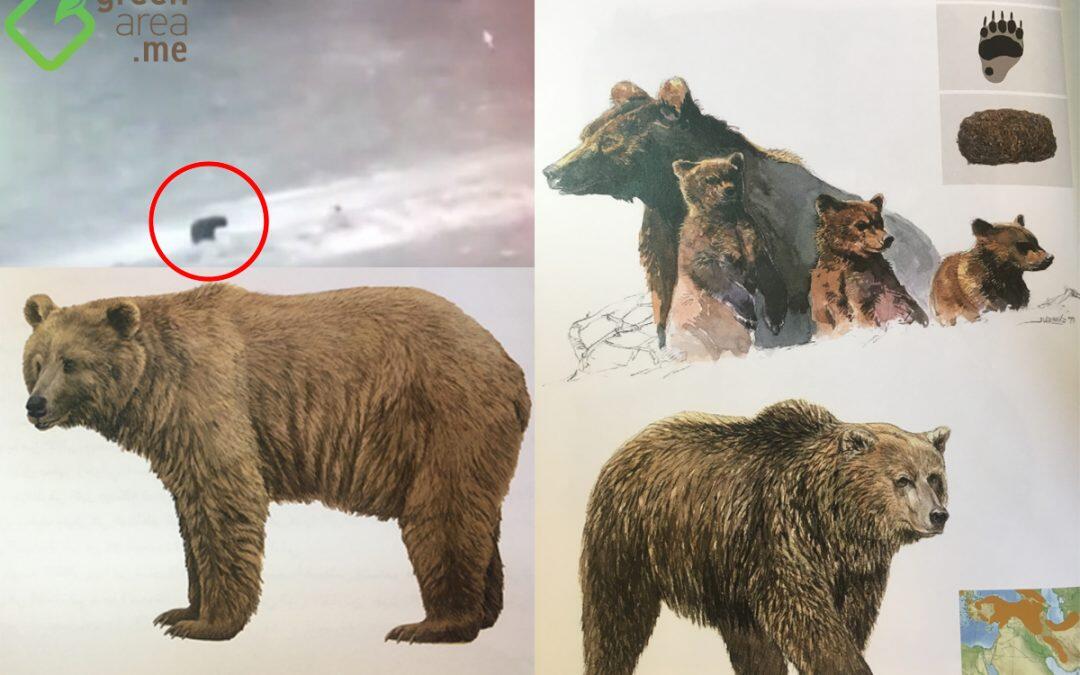Even though Lebanon witnessed many environmental tragedies on more than one level, especially at the level of biological degradation, in the recent days of 2016 a video recorded a unique and distinctive historic event of a documented brown Syrian bear displayed on the barren areas of the eastern chain of Lebanon’ mountains, specifically in the barren mountains of the town of Bee – Baalbek.
According to the available information, a group of young men recorded a videotape, which greenarea.info website obtained a copy of , showing a Female Syrian brown bear appearing with her cub in the Lebanese territory on the snow.
Fouad Itani, a photographer who specializes in documenting wildlife, states that the video was recorded by a group of young people the night of December 29 2016. And unverified news over the past years, never approved by any official source, claimed seeing brown bears in the syrian Jouroud Al Qalamoun in 2015. In 2004 rumor has it that a brown bear was seen in the Syrian village Snir (south east), along with the story concerning the herd of bears that was seen in the same area in 2011.
The Executive Director of the Association of Protection of Nature in Lebanon, Assad Serhal, confirms that the return of the Syrian bear to Lebanon, when it is confirmed conclusively, is a historic event and a very positive index, as the nearest point where this kind of bears is seen is about 500 km away from Turkey’s side. Serhal who published last year in partnership with Saeed al-Khuzai, the book “the guide field of mammals in the Middle East,” adds that there are about 16 different strains of brown bears in the world. The brown bear strain deployed in the eastern Mediterranean is known as the Syrian strain where bears prefer to live in dense forests and mountainous areas.
The brown bear has a body length of about 153cm, a small tail of 3.5 cm, a shoulder height 82cm, and a weight of around 170 Kg; relatively smaller than other subspecies. This subspecies of bear is characterized by the light yellowish color of its fur. It has a powerful body structure and strong muscles. It has a very short tail with short heavy legs (the hind legs are longer than the forelegs). Each wide paw has five toes ending in sharp claws. It has short round ears, small eyes and powerful jaws.
Brown bears inhabit caves and are known for their tendency to roam at night, covering considerable distances. They can live in high snow-covered mountainous areas, hibernating during the winter, whereas those living in warmer areas do not hibernate. They roam long distances during autumn and spring.
As for the factors of the presence of this bear in the blizzard that hit Lebanon in the late 2016, Serhal says “ It’s probably, that this bear was trying to move to a safe area, especially since the Lebanese-Syrian border is experiencing sporadic battles as a result of the war in Syria. The presence of the cub with his mother means that he was born in the spring of 2016 or the previous year because the female does not sponsor (take care of) their young for more than two years.
Serhal adds that female bears are sexually mature at three years of age. After a gestation period of seven months she gives birth in the spring to two cubs which are dependent on their mother for a year or more. The life span of this bear is between 15 and 30 years.
Bears are omnivores feeding on grass, roots, grains, berries, fruit, fish, insects and carrion. They will attack cattle and other domestic and wild animals, particularly in spring when they wake up ravenous after hibernation. Bears also like to feed on chick-peas during the spring and can devastate an entire field. In late summer bears also feed on grapes and they love honey.
Serhal stresses the importance of bears fever system, in documenting the wildlife. Pointing out that the Assembly started the “Protector” program that has been able to document many of the observations relating to animals and birds that were thought to have disappeared once and for all from the nature in Lebanon. Among the most prominent examples documenting activist in the Assembly Berg Tmburean captured via video camera the return of the internationally endangered otter, to Anger- Kffersbd.
The National Council for Scientific Research has announced the extinction of this kind in Lebanon before documenting his appearance in the wet lands in the area of international concern because of its embrace of large numbers of birds and plants, including the Syrian Serin topic on the red list of the International Union for Conservation of Nature.
In his turn the chairman of the association “ knwoin the wildlife center” in Aley Dr. Munir Abu Said, stated that if this video is real and the brown bear is really spotted in the Lebanese territory it would be the first time since 58 years because the last time they were spotted in Lebanon was in 1958.











